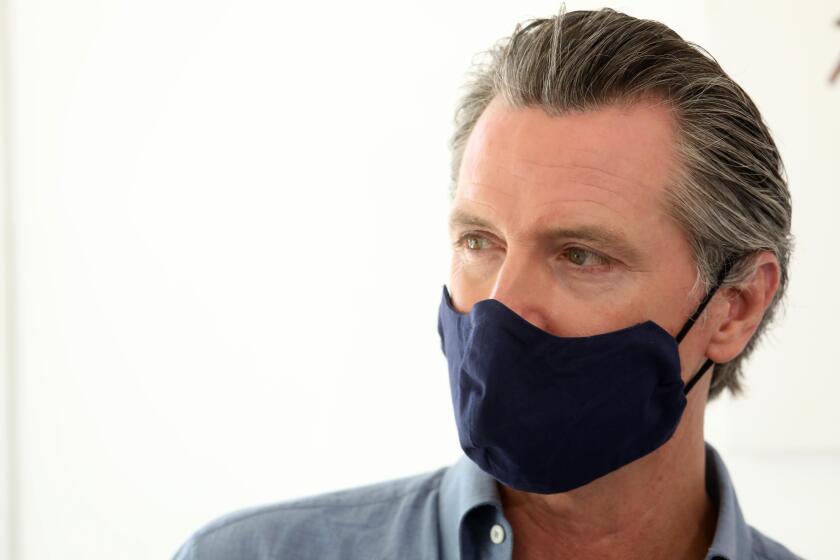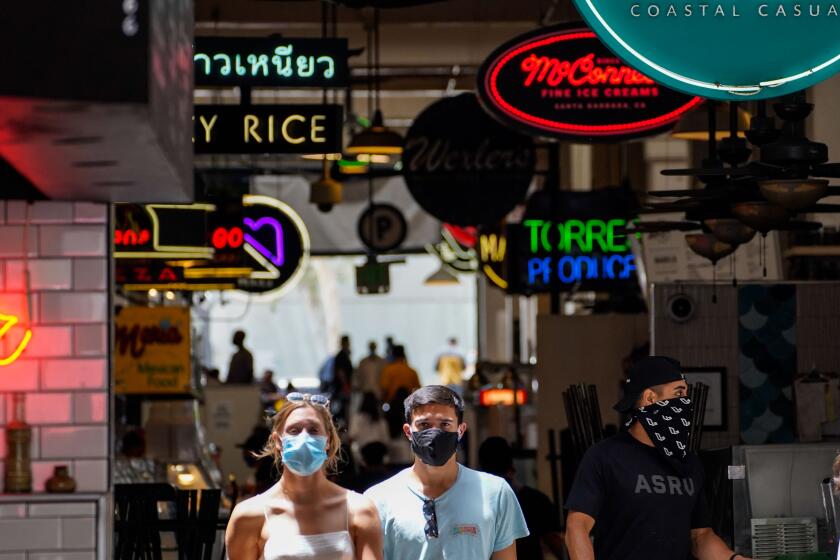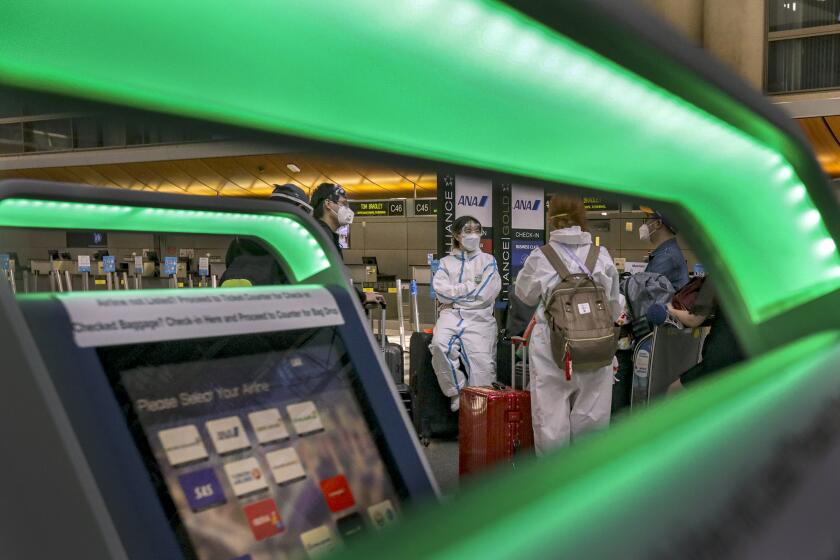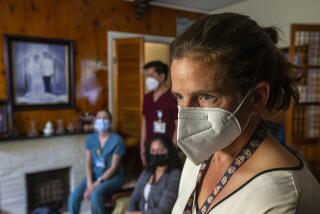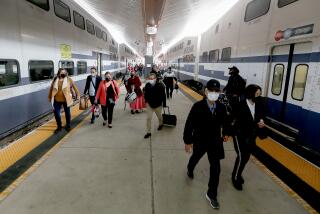Coronavirus packs San Bernardino hospitals; Imperial County told to reinstate stay-at-home order

- Share via
Imperial County has become so overwhelmed by the coronavirus that the state is recommending that county officials reimpose a strict stay-at-home order, Gov. Gavin Newsom said Friday.
Newsom also said the state has “paused” issuing any additional guidelines that would allow counties to accelerate reopening their economies and easing restrictions, likewise in response to the acceleration of COVID-19 hospitalizations, including seriously ill patients sent to intensive care units.
At the same time, San Bernardino County officials said local hospitals are beginning to reach “surge capacity” because of new coronavirus cases, meaning they are getting close to hitting their licensed limits for the number of available beds.
They stressed that there is still room for more patients but said the system is becoming stressed.
The county said it would consider opening alternate care sites for patients if hospitals fill up.
California health officials said the spike in San Bernardino cases and hospitalizations has been caused by workplace transmission as well as transmissions at state prisons, hospitals, county jails and skilled nursing facilities and by the transfer of hospitalized patients from Imperial County.
The shift came a day after the number of coronavirus cases in California surpassed 200,000 as the state continues to report a surge in new infections that officials now say cannot be explained by increased testing alone.
Newsom said that over the last 14 days, nearly one of every four people tested in Imperial County has been positive for the coronavirus, far above the statewide average of one of every 20 residents. More than 500 hospital patients have been transferred out of the county to relieve pressure on hospitals in the rural county.
With 5,744 cases and 73 deaths, Imperial County has the highest rate of coronavirus cases per capita in California, according to The Times’ tracker. It also has the highest test positivity rate of any county in the state, with a seven-day average of 23%, compared with 5.7% statewide, Newsom said Friday.
“We are advising and counseling them to move forward and reinstitute a stay-at-home order, but they will move at their discretion,” he said. “If they are not able to come to some consensus, I am committed to intervening as is my role and responsibility as governor in the state of California.”
Imperial is among the 15 California counties the state is monitoring because they have exceeded criteria set by the state to address the pandemic, including thresholds for hospitalizations and positive COVID-19 tests.
Gov. Gavin Newsom said the number of people hospitalized from COVID-19 in California has grown 32% in the last two weeks.
The Newsom administration is working with health officials in those 15 counties to ensure they receive state support, whether that means sending additional healthcare workers or ventilators or moving COVID-19 patients to other counties.
The governor said the decision to pause the release of state guidelines was made a week ago and influenced Disney’s decision to delay the reopening of its theme parks in Anaheim.
“We’re advising and encouraging counties like Imperial ... to toggle back,” Newsom said. “We are acknowledging as a state well over a week ago that we were not moving forward, that we’d already paused the reopening of certain sectors of our economy with guidelines that were coming out.”
Newsom said state health officials are working with the the Centers for Disease Control and Prevention to determine whether the outbreak in Imperial County has been exacerbated by COVID-19 patients coming in from Arizona, now a coronavirus hot spot, and Mexico. The county borders both.
Newsom said the study is focused on specific health data, not “political punditry.” He said the results of the study could be delivered as early as today.
San Francisco is also pausing the relaxation of its stay-at-home orders amid a rise in new cases, Mayor London Breed announced Friday.
The city was scheduled on Monday to permit the reopening of outdoor bars, museums, zoos, tattoo parlors and personal care services, such as hair and nail salons and massage studios, but will now hold off, Breed said.
“Our reopening process is guided by data and science,” she wrote in a tweet. “COVID-19 cases are rising throughout CA. We’re now seeing a rise in cases in SF too. Our numbers are still low but rising rapidly.”
San Francisco had reported 3,400 cases of the virus and 48 deaths, as of Thursday.
Newsom indicated Friday that the decision was made by local authorities, not the state.
“What San Francisco did is exactly what the system was designed to do, and that is to empower local health officers, based upon the conditions in their communities,” he said. “Remember, I can’t say this enough. California is not one size fits all.”
The news comes amid skyrocketing numbers of coronavirus cases across California.
The state shattered a daily record for new cases Monday, reporting more than 6,000 infections for the first time. That number surged even higher Tuesday, when 6,652 new cases were reported. The state reported 4,629 new cases Wednesday and 5,069 on Thursday, according to The Times’ coronavirus tracker — pushing its cumulative total past 200,000.
Officials have attributed some of the increase in daily case counts to more tests being performed and said that other metrics, like the average number of daily hospitalizations and the overall rate of people testing positive, give a better picture of how the state is faring in its fight against the virus.
Both of those metrics now suggest the virus’ spread has indeed accelerated.
California has seen a 32% increase in hospitalizations of patients with confirmed COVID-19 disease, and a 19% jump in ICU patients with verified infections, over the past 14 days.
The rate at which coronavirus tests are confirming infections is also on the rise. On Thursday, 5.6% of coronavirus test results were positive on average over the previous seven days; a week earlier, 4.6% were coming back positive for the virus, according to a Los Angeles Times analysis. By Friday, the rate had increased slightly to 5.7%, Newsom said.
The alarming recent surge in COVID-19 cases appears to be driven at least in part by increases in infections among Californians ages 18 to 49.
Los Angeles County continues to be a hotbed of new infections, accounting for more than 45% of the state’s total cases and more than 55% of its COVID-19 deaths. The county’s director of public health, Barbara Ferrer, on Thursday reported more than 2,000 new cases for the fourth time in a week.
“As you may be aware, the data is now showing concerning trends,” Ferrer said in a statement. “This week we have seen cases increase, hospitalizations increase, and the positivity rate for testing increase.”
After several weeks of relative stability, L.A. County’s most recent three-day average of daily hospitalizations reflected a 9% increase, according to the Department of Public Health dashboard that tracks reopening metrics.
There were 1,633 confirmed coronavirus patients in county hospitals Thursday, with 25% in intensive care and 18% on ventilators.
There was concern the increase could stress the healthcare system, should the trend persist.
Dr. Christina Ghaly, L.A. County’s director of health services, said Monday that, while the county has enough available hospital beds, the number of beds in intensive care units may become limited in coming weeks.
The Times has now identified a third flight into LAX in which public health officials in the early stage of the COVID-19 pandemic did not alert travelers that they were at risk for infection.
Since then, the four hospitals run by the Department of Health Services reported a 36% drop in total available ICU beds, from roughly 50 available beds on Monday to 32 available beds Friday.
L.A. County’s 70 designated 911 receiving hospitals together reported a 14% decrease in available ICU beds between Monday and Thursday, from 188 available beds to 161, according to data released by the Department of Health Services.
Still, the most recent three-day average of available ICU beds reported by the county, which is considered a more stable indicator, reflected a 5% increase in capacity, according to the Department of Public Health dashboard.
The county’s overall positivity rate is also creeping upward, reaching 9% Friday after holding at 8% since late May, officials said. A total of 1,020,322 people in L.A. County had been tested for the coronavirus and received their results.
“We also know that the average age of the people who are infected, including those who are newly infected, is trending younger than before,” Ferrer said Thursday.
About 40% of coronavirus cases in L.A. County are occurring among those 18 to 40 years old.
Ferrer said earlier this week that it was “highly likely” that the rise in new cases is related to people gathering during protests, in addition to clusters of visitors at restaurants and parties as well as newly reopened workplaces where employees are in close contact with one another.
Cells hijacked by the coronavirus grow long, streaming tentacles to reach out to new victims, scientists found. This could complicate the search for a vaccine.
The virus appears to be spreading more rapidly elsewhere in the state, as well.
In addition to Los Angeles and Imperial, 13 counties have reported elevated transmission of the disease, increased hospitalizations or a limited hospital capacity that exceed the state’s guidelines: Contra Costa, Fresno, Kern, Kings, Riverside, Sacramento, San Bernardino, San Joaquin, Santa Barbara, Santa Clara, Stanislaus, Tulare and Ventura.
The state’s public health team is working with those counties to provide targeted support to help identify and deal with the specific drivers of the increases, and to ensure that the surges don’t overwhelm the hospital system.
“Certainly if we get to a point where despite all of those collaborative good efforts, a county needs to assert themselves or get support from the state to reintroduce some level of modifications to how people are moving, the state and counties are prepared for that,” Mark Ghaly, the state’s secretary of Health and Human Services, said earlier this month.
Orange County, which is not on the state’s targeted engagement list, reported 26 COVID-19 deaths Wednesday — its most in a single day. Officials noted that not all of those people died on that particular day. The recently reported fatalities date as far back as May 9, according to the Orange County Health Care Agency.
Though the county also reported 506 new coronavirus infections Thursday, the local Health Care Agency said the number “reflects another large batch of cases” from a state reporting system and that these individuals who tested positive “had their specimens collected over 28 different dates.”
On Thursday, the county announced another seven fatalities, pushing its total coronavirus-linked death toll to 306.
Times staff writers Colleen Shalby and Soumya Karlamangla contributed to this report.
More to Read
Sign up for Essential California
The most important California stories and recommendations in your inbox every morning.
You may occasionally receive promotional content from the Los Angeles Times.
